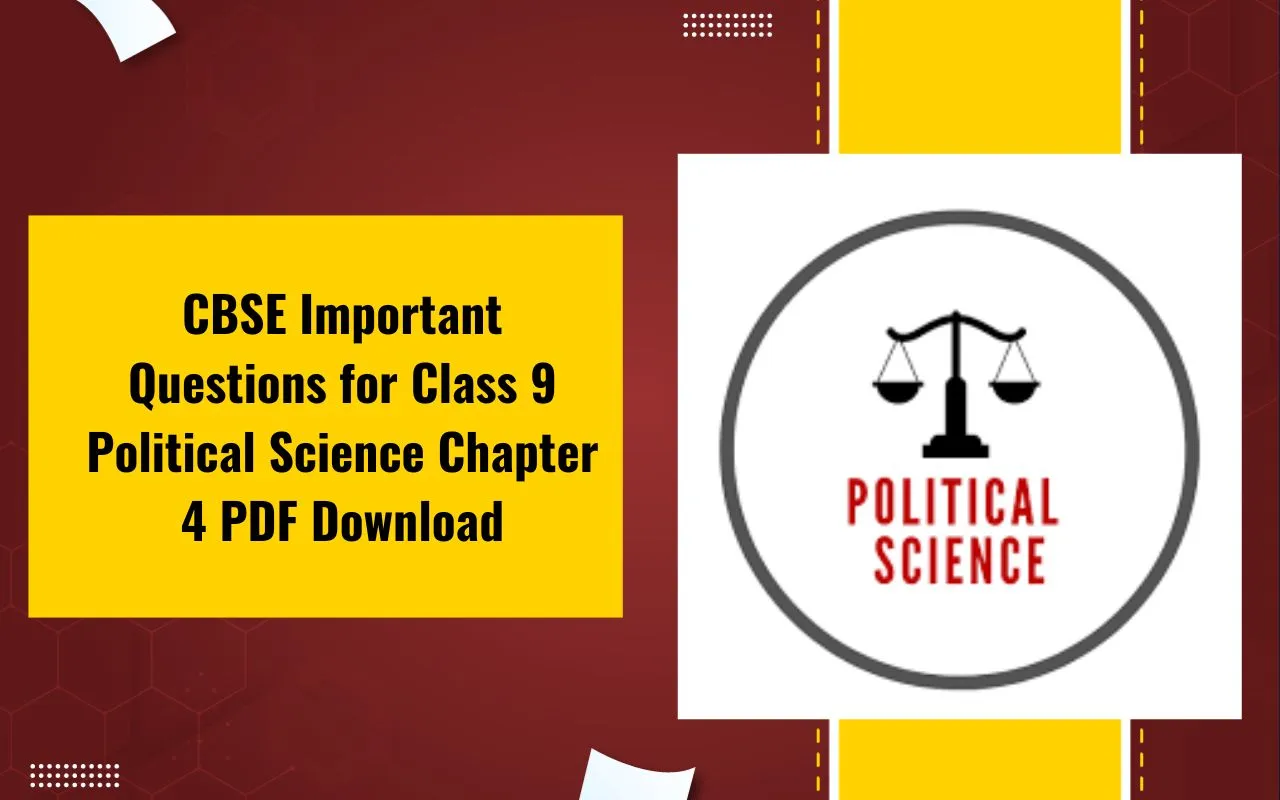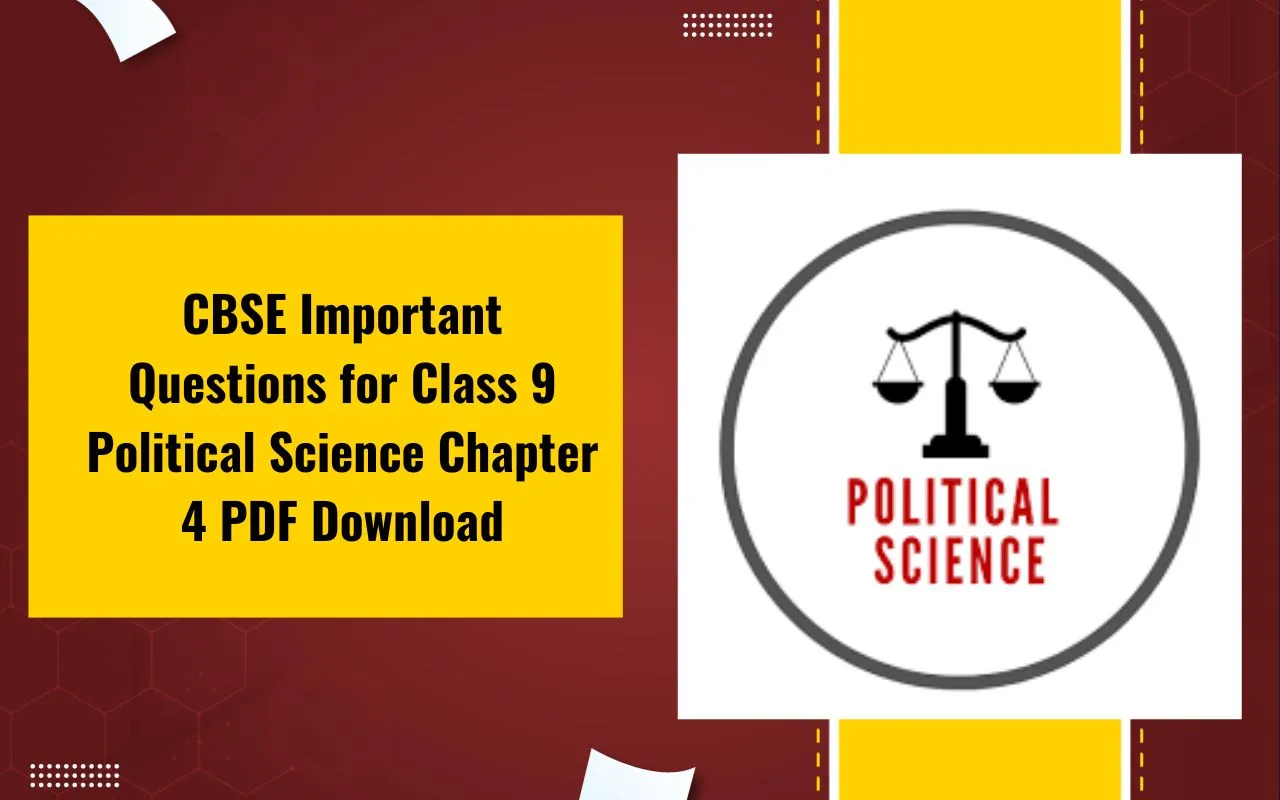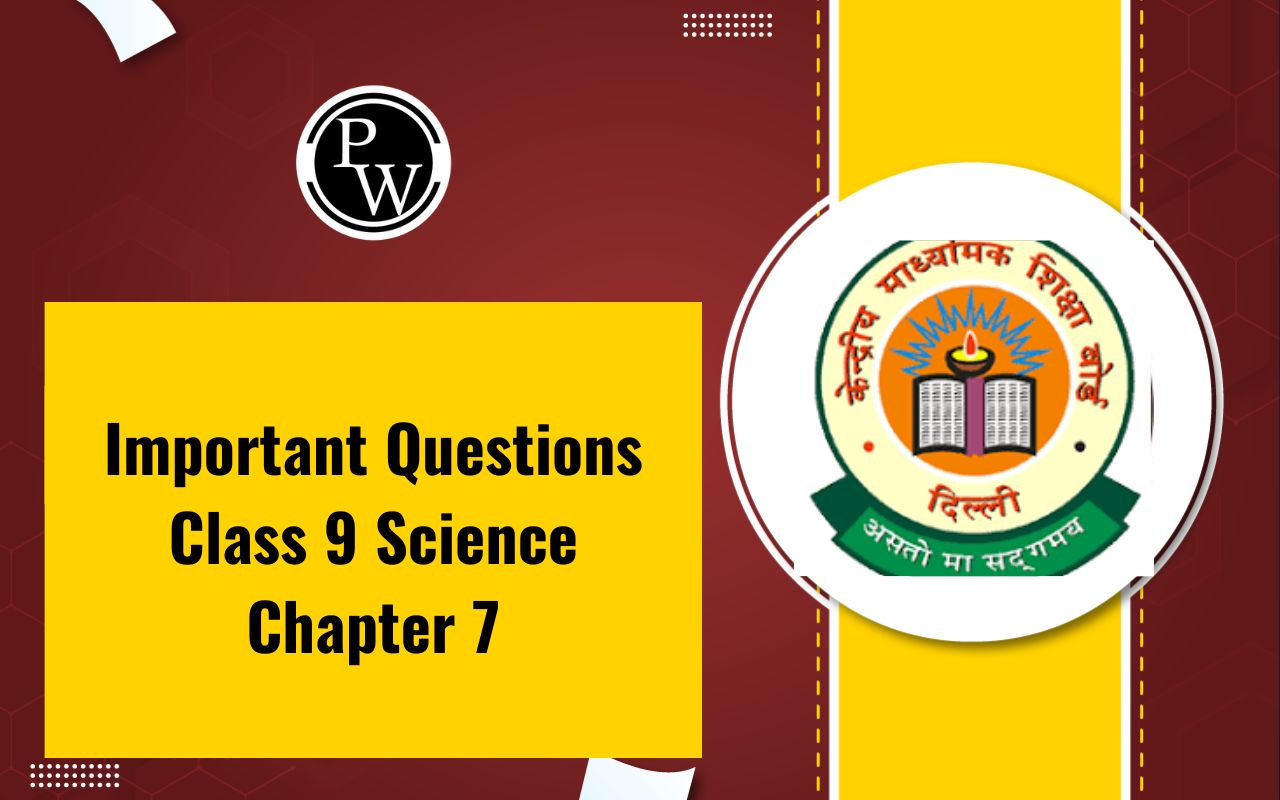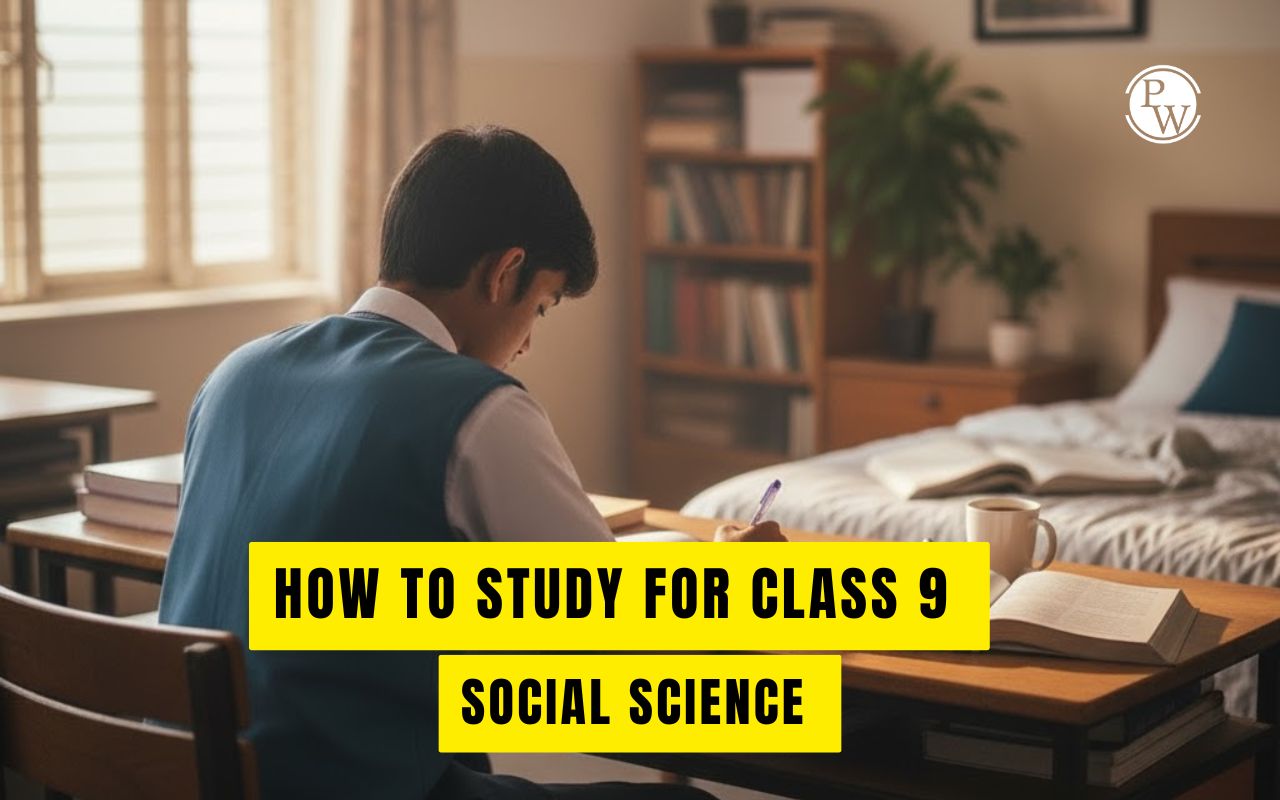

CBSE Important Questions for Class 9 Political Science Chapter 4: In Chapter 4 of Class 9 Political Science, titled Working of Institutions, the focus is on understanding the functioning of various political institutions in a democracy, such as the Parliament, the Prime Minister, the Council of Ministers, and the Judiciary.
This chapter discusses how power is divided among these institutions and how they interact to ensure checks and balances in the governance process.
Important questions in this chapter often revolve around the roles and functions of these institutions, the process of decision-making, and the relationship between different branches of government.
Students may be asked to explain the decision-making process in the Parliament, describe the role of the Prime Minister, or discuss the significance of the Judiciary in safeguarding democracy. Understanding the structure and functioning of these institutions helps students grasp how power is exercised in a democratic system.
CBSE Important Questions for Class 9 Political Science Chapter 4 Working of Institutions Overview
In this chapter of Class 9 Political Science, titled Working of Institutions, students learn about the functioning and interrelationship between the key political institutions in India: the Parliament, the Prime Minister, the President, the Judiciary, and the Council of Ministers. The chapter explains how these institutions work together to ensure smooth governance and the effective functioning of Indian democracy.
The chapter covers the following sections:
-
The Parliament and its Role: This section discusses how the Parliament is responsible for making laws, framing policies, and representing the citizens. It introduces students to the two houses of Parliament - the Lok Sabha (House of the People) and the Rajya Sabha (Council of States), explaining their powers and functions.
-
The Prime Minister and the Cabinet: This part explains the crucial role played by the Prime Minister and the Council of Ministers in the executive branch of the government. It describes the powers and functions of the Prime Minister, how decisions are made, and the relationship between the Prime Minister, the President, and the Parliament.
-
The Role of the Judiciary: The judiciary's role in ensuring the rule of law, protecting the Constitution, and safeguarding fundamental rights is discussed here. The judiciary also checks the powers of the legislature and the executive, and this section explains the independence of the judiciary in upholding justice.
-
The President’s Role: Although the President of India is a ceremonial head of state, this section explains the powers and functions they hold in the governance process, such as appointing the Prime Minister and other ministers, and their role in legislative procedures.
-
Separation of Powers: The chapter emphasizes the importance of the separation of powers among the legislature, executive, and judiciary to maintain checks and balances. It shows how this structure ensures no one institution has too much power and prevents misuse of authority.
CBSE Important Questions for Class 9 Political Science Chapter 4 Working of Institutions PDF
You can download the CBSE Important Questions for Class 9 Political Science Chapter 4: Working of Institutions PDF by following the link provided below. This PDF contains a detailed collection of important questions that will help you understand the key concepts related to the functioning of various political institutions in India, such as the Parliament, the Judiciary, the President, and the Prime Minister. By reviewing these important questions, you can strengthen your grasp on the chapter and enhance your understanding of the working of democratic institutions in India.
CBSE Important Questions for Class 9 Political Science Chapter 4 Working of Institutions PDF
CBSE Important Questions for Class 9 Political Science Chapter 4 Working of Institutions
Here are some important questions from Chapter 4 Working of Institutions of Class 9 Political Science, which are important for exams:
1. Which of the following statements about the judiciary is false?
(A) Every law passed by the Parliament needs approval of the Supreme Court.
(B) Judiciary can strike down a law if it goes against the spirit of the Constitution.
(C) Judiciary is independent of the Executive.
(D) Any citizen can approach the courts if her rights are violated.
Ans. (A) Every law passed by the Parliament needs approval of the Supreme Court.
2. Which of the following institutions can make changes to an existing law of the country?
(A) The Supreme Court
(B) The President
(C) The Prime Minister
(D) The Parliament
Ans. (D) The Parliament
3. Assertion: The primary role of the judiciary is to make laws.
Reason: The judiciary interprets and upholds laws but does not have the authority to create new laws.
(A) Both Assertion (A) and Reason (R) are true and Reason (R) is the correct explanation of Assertion (A).
(B) Both Assertion (A) and Reason (R) are true and Reason (R) is not the correct explanation of Assertion (A).
(C) Assertion (A) is true but Reason (R) is false.
(D) Assertion (A) is false but Reason (R) is true.
Ans. (D) Assertion (A) is false but Reason (R) is true.
4. Statement-I: Minimum age is 21 years to become a member of Lok Sabha.
Statement-II: Minimum age is 30 years to become a member in Rajya Sabha.
(A) Both Statement-I and Statement-II are correct.
(B) Both Statement-I and Statement-II are incorrect.
(C) Statement-I is correct & Statement-II is incorrect.
(D) Statement-I is incorrect & Statement-II is correct.
Ans. (D) Statement-I is incorrect & Statement-II is correct.
5. Statement-I: National emergency is under article 352.
Statement-II: Financial emergency is under article 360.
(A) Both Statement-I and Statement-II are correct.
(B) Both Statement-I and Statement-II are incorrect.
(C) Statement-I is correct & Statement-II is incorrect.
(D) Statement-I is incorrect & Statement-II is correct.
Ans. (A) Both Statement-I and Statement-II are correct.
6. Who elects the Speaker and the Deputy Speaker of the Lok Sabha?
(A) The President
(B) The Prime Minister
(C) The members of Lok Sabha
(D) The members of Rajya Sabha
Ans. (C) The members of Lok Sabha
7. Who is the head of the Government in India?
Ans. Prime Minister of India is the head the government in India. He runs all the operations of the government with the help of the cabinet he heads.
8. How and on what grounds can the President be removed from office?
Ans. The President of India can be removed from office through impeachment by Parliament for violation of the Constitution. The process requires a motion signed by at least one-fourth of the total members of either House of Parliament and is passed by a majority of two-thirds of the members present and voting, followed by approval from the other House.
9. Distinguish between the Cabinet and the Council of Ministers
Ans. The Cabinet and the Council of Ministers are both crucial bodies in a government, yet they operate differently:
Composition: The Cabinet comprises highranking ministers chosen by the Prime Minister, often with specific portfolios, while the Council of Ministers includes all ministers, junior and senior.
Decision-making: The Cabinet is responsible for major policy decisions and strategies, often meeting regularly to discuss and decide on key issues. Conversely, the Council of Ministers involves a broader discussion and is more consultative in nature.
Authority: Cabinet decisions hold more weight and are often binding on the government, whereas the Council of Ministers provides input and advice but lacks the same authority.
Hierarchy: The Cabinet is a subset of the Council of Ministers, consisting of the most influential members, while the Council encompasses the entire ministerial body.
Efficiency: The Cabinet's smaller size enables quicker decision-making and more focused discussions, whereas the Council's larger membership may lead to longer deliberations and consensus-building.
10. How is the Prime Minister of India appointed?
Ans. The following process is followed in India to appoint the Prime Minister of India.
• The Prime Minister of India is appointed by the President.
• After general elections, the leader of the majority party or coalition in the Lok Sabha (House of the People) is usually chosen.
• The President then invites this leader to form the government.
• The Prime Minister-designate selects other ministers to form the Council of Ministers.
• Once the Council is formed, it is sworn in by the President.
• The Prime Minister holds office as long as they enjoy the confidence of the majority in the Lok Sabha.
11. Why is it necessary to keep the judiciary independent of the government?
Ans. Maintaining an independent judiciary is crucial for upholding the rule of law and ensuring justice prevails. When the judiciary is separate from the government, it can impartially interpret and apply laws without political influence. This independence safeguards against authoritarianism, ensures accountability of those in power, and protects citizens' rights and freedoms. It fosters public trust in the legal system, promoting stability and fairness in society. Without it, there's a risk of injustice, abuse of power, and erosion of democratic principles.
12. Explain the emergency powers of the President.
Ans. Emergency Powers and Functions of President are In addition to the normal powers mentioned above, the Constitution confers extraordinary powers on the President to deal with the following three types of emergencies:
• National Emergency (Article 352)
Article 352 of the Indian Constitution grants the President the power to declare a national emergency in cases of perceived threat to the country's security or integrity
President’s Rule (Article 356 & 365)
Article 356 of the Indian Constitution allows the President to impose President's Rule in a state if the state government fails to function according to constitutional provisions. Article 365 deals with directions to states.
Financial Emergency (Article 360)
Article 360 of the Indian Constitution enables the President to proclaim a financial emergency if the financial stability or credit of India or any part thereof is threatened.
13. Distinguished between parliamentary and Presidential form of Government?
Ans. Parliamentary System of Government
• Is based on a fusion of legislative and Executive orders
• There is a presence of a nominal head and a real head. The President who is the head of the state is actually only a nominal head. All his powers are exercised by the Prime Minister who is the real executive.
• The executive is collectively and individually Responsible for the legislature.
• The tenure of the cabinet depends on the support it commands in the legislature.
• The minister initiates important bills in the legislature.
• All ministers have to be members of the legislature and are accountable to it.
Presidential form of Government
• Is based on separation of powers where all. The three organs of government are Separate
• Such a distinction does not exist and the President is the real executive.
• The President is not responsible to the Legislature.
• The President enjoys a fixed tenure
• The members of the President’s cabinet Cannot initiate any bills in the legislature.
• President’s Cabinet consists of experts Who are not accountable to the legislature
14. Explain the executive powers of the Presidents?
Ans. Executive powers president is as following:
• The President of India is the formal head of the executive branch of the government, and all actions taken by the government are carried out in his name.
• He has the power to establish rules for authenticating official documents and instruments, as well as to streamline the administration of government business and allocate tasks among ministers. (Article 77)
• He has the authority to appoint the Prime Minister and other ministers, as well as other key officials such as the Attorney General, the Comptroller and Auditor General, and State Governors etc. (Article 75)
• He can also request information from the Prime Minister and other ministers. (Article 78)
• He has the authority to appoint administrators for Union Territories (Article 239) and has the power to declare certain areas as scheduled or tribal areas (Article 244).
15. What are the qualifications required for contesting the election for the post of the President?
Ans. To contest the election for the post of President in India, a candidate must fulfill the following qualifications:
• They must be a citizen of India.
• At least 35 years of age.
• Eligible to be a member of the Lok Sabha.
• Not hold any office of profit under the Government of India, any state government, or any local authority.
• The Prime Minister of India is appointed by the President.
• After general elections, the leader of the majority party or coalition in the Lok Sabha (House of the People) is usually chosen.
• The President then invites this leader to form the government
. • The Prime Minister-designate selects other ministers to form the Council of Ministers.
• Once the Council is formed, it is sworn in by the President
. • The Prime Minister holds office as long as they enjoy the confidence of the majority in the Lok Sabha.
16. Mention any four powers of the parliament.
Ans. Parliamentary powers typically include
(i) Parliament has the authority to make laws on various subjects within its jurisdiction.
(ii) Parliament controls the nation's finances, including budget approval and taxation
(iii) It monitors and scrutinizes the actions of the executive branch, ensuring accountability.
(iv) Parliament may have the authority to amend the constitution or enact fundamental laws
17. How is the Chief justice of India appointed?
Ans. The President appoints the Chief Justice of India based on seniority and consultation with the senior most judges of supreme court of India.
18. How is the President of India elected?
Ans. The President of India is elected indirectly by an electoral college comprising elected members of both houses of Parliament and state legislatures.
19. Name any three institutions responsible to run democratic government in India.
Ans. The three key institutions responsible for running a democratic government in India are:
(i) The Parliament
(ii) The Executive
(iii) The Judiciary
Benefits of Solving CBSE Important Questions for Class 9 Political Science Chapter 4
Better Understanding of Key Concepts: The chapter focuses on the functioning of critical political institutions such as the Parliament, Judiciary, the President, and the Prime Minister.
By practicing these questions, students get a deeper understanding of how these institutions work, their roles, and their interrelationship within the Indian political system.
Reinforcement of Theoretical Knowledge: Answering important questions helps reinforce the theoretical concepts learned in class.
It encourages students to recall and apply the principles of democracy, governance, and the separation of powers within India's political framework.
Increased Retention: Repeated practice of important questions helps in better retention of the subject matter. It allows students to familiarize themselves with the type of questions they may encounter in the exam and boosts memory recall under time constraints.
Enhanced Exam Preparation: These questions are designed to target the core areas of the syllabus, ensuring that students are well-prepared for the exams. By solving these questions, students can identify important topics and focus on them during their revision sessions.
Improved Analytical and Critical Thinking: Political Science often requires an analytical approach. Solving such questions helps students improve their critical thinking skills, as they must analyze the functioning of institutions and evaluate their impact on the Indian political system.
Time Management Skills: Practicing these important questions enables students to develop effective time management skills, helping them answer questions accurately and efficiently during the exams.
Boosts Confidence: Regularly solving important questions builds confidence in students. It helps them approach the exam with a positive mindset, knowing they have practiced the necessary content and are well-prepared.
CBSE Important Questions for Class 9 Political Science Chapter 4 FAQs
What is the main focus of Chapter 4 Working of Institutions in Political Science?
Why are CBSE Important Questions for Chapter 4 helpful for students?
Can solving these questions improve my conceptual clarity?
Should I solve these questions as part of my regular revision?













